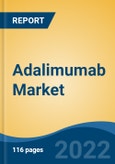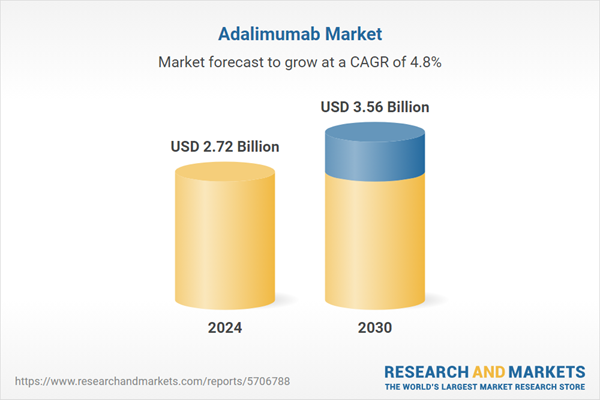Speak directly to the analyst to clarify any post sales queries you may have.
10% Free customizationThis report comes with 10% free customization, enabling you to add data that meets your specific business needs.
Key Market Drivers
Growth in Healthcare Industry
The expanding global healthcare industry, generating annual revenues exceeding USD 4 trillion, is significantly driving the adalimumab market forward. Pharmaceuticals and biotechnology, accounting for nearly USD 850 billion, represent key contributors to this growth. As healthcare infrastructure improves across developed and emerging regions, diagnoses of autoimmune diseases such as rheumatoid arthritis, psoriatic arthritis, and Crohn’s disease are becoming more common - boosting demand for adalimumab. Advanced diagnostics and early intervention, made possible by rising investment in healthcare systems, are leading to increased use of targeted biologics.Government support, private sector investment, and broader insurance coverage are also making high-cost treatments more accessible. With global healthcare spending reaching USD 9.8 trillion in 2021, representing over 10% of global GDP, emerging markets are witnessing improved patient access to biologics through expanded hospital networks and reform-driven health systems. As a result, adalimumab continues to benefit from these advancements, cementing its position as a frontline treatment in immunology.
Key Market Challenges
High Cost of Production
A key challenge in the global adalimumab market is the high cost of biologic drug production. The manufacturing of adalimumab, a complex monoclonal antibody, involves intricate biotechnological methods that require substantial investment in specialized infrastructure, skilled personnel, and regulatory compliance. The use of living cells in the development process, combined with tightly controlled manufacturing conditions, contributes to elevated production costs. Critical stages such as cell culture, purification, and formulation are both time-consuming and resource-intensive. Furthermore, risks such as batch failure and the rigorous validation requirements further strain cost efficiency. These high production costs pose a barrier for manufacturers, particularly when attempting to scale or introduce biosimilars in competitive markets.Key Market Trends
Rising Prevalence of Chronic Diseases
The growing incidence of autoimmune and inflammatory diseases represents a significant trend shaping the adalimumab market. Conditions like rheumatoid arthritis, ulcerative colitis, psoriasis, and Crohn’s disease are becoming more prevalent, driven by aging populations, sedentary lifestyles, and environmental triggers. As these chronic conditions often require long-term treatment, demand for reliable and effective biologics continues to rise. Adalimumab, with its broad therapeutic indications and established clinical profile, remains a preferred option for managing chronic inflammation. It was the first fully human monoclonal antibody to receive approval for rheumatoid arthritis and has since proven its safety and efficacy in long-term use. This growing reliance on biologics underscores the sustained role of adalimumab in immunological treatment strategies worldwide.Key Market Players
- AbbVie Inc.
- Pfizer, Inc.
- Amgen Inc.
- Novartis AG
- Torrent Pharmaceuticals Ltd.
- Cadila Healthcare Limited
- Boehringer Ingelheim International GmbH
- Mylan N.V.
- Hetero Biopharma Ltd
- Samsung Bioepis Co Ltd.
Report Scope
In this report, the Global Adalimumab Market has been segmented into the following categories, in addition to the industry trends which have also been detailed below:Adalimumab Market, By Type:
- Biologics
- Biosimilars
Adalimumab Market, By Therapeutic Area:
- Rheumatoid Arthritis
- Psoriatic Arthritis
- Psoriasis
- Crohn’s Disease
- Others
Adalimumab Market, By Region:
- North America
- United States
- Canada
- Mexico
- Europe
- France
- United Kingdom
- Italy
- Germany
- Spain
- Asia Pacific
- China
- India
- Japan
- Australia
- South Korea
- South America
- Brazil
- Argentina
- Colombia
- Middle East & Africa
- South Africa
- Saudi Arabia
- UAE
Competitive Landscape
Company Profiles: Detailed analysis of the major companies present in the Global Adalimumab Market.Available Customizations
With the given market data, the publisher offers customizations according to a company's specific needs. The following customization options are available for the report.Company Information
- Detailed analysis and profiling of additional market players (up to five).
This product will be delivered within 1-3 business days.
Table of Contents
Companies Mentioned
- Abbvie Inc.
- Pfizer, Inc.
- Amgen Inc.
- Novartis AG
- Torrent Pharmaceuticals Ltd.
- Cadila Healthcare Limited
- Boehringer Ingelheim International GmbH
- Mylan N.V.
- Hetero Biopharma Ltd
- Samsung Bioepis Co Ltd.
Table Information
| Report Attribute | Details |
|---|---|
| No. of Pages | 185 |
| Published | June 2025 |
| Forecast Period | 2024 - 2030 |
| Estimated Market Value ( USD | $ 2.72 Billion |
| Forecasted Market Value ( USD | $ 3.56 Billion |
| Compound Annual Growth Rate | 4.8% |
| Regions Covered | Global |
| No. of Companies Mentioned | 10 |









